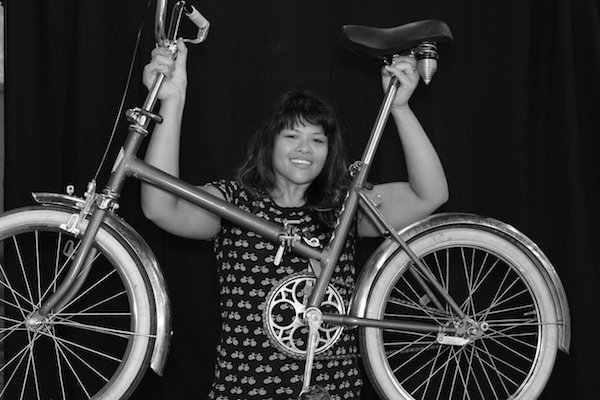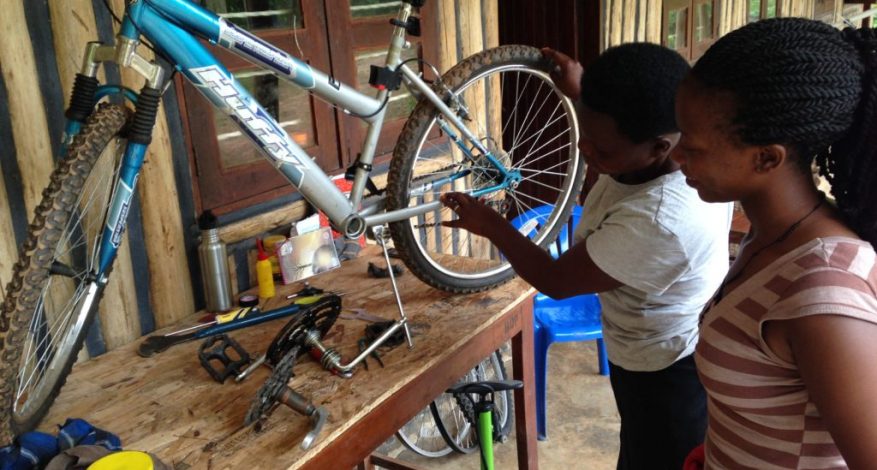Captain’s Log 2: Patrick in Uganda Second Update
When the orupaanga touches the bretch pad on the buryo side, we can tighten the enuti empajye on the bumosho side with the spanner empajye, and that should pull the orupaanga back to the bumosho side. This operation can only be done a certain number of times until we run out of ehuzi ye’mpajye. In that way, each omupiira can only live for so long.
The dominant tribe in this area, and most of south west Uganda are the Bakiga, their language is Rukiga. The Bakiga are one of many tribes speaking one of hundreds of Bantu languages. I vaguely remember something about the Bantu expansion from an undergraduate anthropology course. The internet reminds me that they undertook a massive migration and population increase from an area in modern Cameroon, in a broad south east direction starting perhaps in 1000 BC and continuing to AD 500. Descendants of the Bantu expansion make up the largest ethno-linguistic group in Sub-Saharan Africa. Their migration brought them into contact with indigenous groups like the Batwa, here in Bwindi, and the Khoisan in South Africa. The Batwa, commonly known as Pygmies, have a troubled and seemingly enigmatic history in the area and will be a topic of a subsequent report. All the Mutwa (a Batwa individual) that I’ve met speak Rukiga, and varying levels of English comparable to the Mukiga.
So far I’ve only encountered two locals with whom I can speak in a rapid fire American
dialect. The accent of Ugandan English is heavy and requires patience between both interlocutors. I’ve noticed that two children of American medical volunteers often address the Africans in what sounds to me like a heavy South African accent. The Africans told me that the children lubricate their words and they hear them quite clearly. I’ve yet to muster the audacity or drink enough waragi (banana moonshine) to affect a similar accent but I am considering it. If my wifi connection is strong enough unlikely I’ll re-watch Niel Blomkamp’s 2009 sci-fi film District 9 and maybe give it a try. Meanwhile, one of the most helpful things I’ve done in the bicycle mechanic training, is try and use Rukiga nouns for the bicycle parts. It is much better than using English terms that no one is familiar with, or saying “this one” every five words. Sometimes pronunciation is all that matters, brake becomes bretch, and circle becomes sarcle. A cone nut might not look like an actual cone until someone tells you that is does. If you can’t understand what that someone is saying or don’t know what a ‘cone’ is, how many ‘this ones’ will you be able to file in your mind? Thankfully, everyone seems to understand that an enuti omubirikira kind of looks like an omubirikira.
A phrase favored by my father’s fifth grade math teacher places the burden on the listener: “when they were handing out brains, you though they said trains, and buddy you missed it.” Here in Bwindi, the burden is on me, the speaker. If I say cone, and they think I said phone, then no one is going to answer it.
Captain’s Log: Patrick in Uganda First Update
Report number 1
On the long flight to Uganda I reread King Leopold’s Ghost by Adam Hochschild. The book documents the tragic history of the Congo Free State, the personal colony of Leopold II King of the Belgians from 1885 – 1908. King Leopold made an incredible personal fortune, initially through the Ivory trade, later and more substantially through the harvest of wild rubber. He was able to profit during a short window between the industrial worlds realization of rubber’s value, and the maturation of cultivated rubber trees. In between, an extensive and murderous regime of forced labor was used to harvest wild rubber vines.
A few individuals in the history were of pertinence to Working Bikes. John Boyd Dunlap invented the first pneumatic rubber tire for his son’s tricycle in Ireland in 1887. William Henry Sheppard, an African American minister from Virginia, and early critic of Leopold’s regime, claimed to have been the first person to ride a bicycle in central Africa.
Two containers of bikes are sitting in a small valley. In one direction, Bwindi Impenetrable Forest National Park rises over the adjacent hillside. On the last leg of my arrival, in a 12 passenger Cessna with one propeller, I was able to take it a spectacular view of the forest interspersed with passing through three rain showers. From above, it resembled mountains made of broccoli blossoms. I marveled at the national park before wondering if in decades and centuries past, perhaps this entire region was as lush. This protected patch of 128 square miles are home to half of the worlds remaining population of mountain Gorillas. Over a hill in the other direction lies the Democratic Republic of the Congo.
Work on the bicycle program has not quite begun. I am still gathering supplies and being introduced to interested community members. Yesterday I sourced a tub of grease and two bottles of lite lubricating oil from the local hardware store, which was less than half the size of Working Bike’s stock room. We have secured access to a large storage room and shaded veranda in a building a few yards from the containers. I was able to bring two of each common bicycle specific tool in my baggage. An employee from Bwindi Community Hospital is in Kampala, the capitol city, purchasing non-bicycle specific tools today. They should arrive by bus on Friday. This afternoon I’ll continue my introductions, saw a few sheets of working bikes particle board to place over tables that are being temporarily loaned, and begin to get a few bikes in proper order. It is my understanding that our trainees likely do not know how to ride a bike. Learning to ride will be their first introduction to the project.
I’ve been met with both optimism and skepticism about how the project will work and if it can be sustainable. Factors I had not considered include a cultural reluctance for women to ride bicycles. The few flying pigeon style roadsters I’ve seen have been piloted by man. All of the women in the area are seen wearing skirts, so step thru frames may be of a particular advantage. During the mechanic training, our participants will not be paid, and may not be rewarded for some time, until the bikes can be sold. I’ve learned that during the training, lunch will have to be provided and arrangements are being made for a pot of beans to slow cook over embers each day. I’ve been told that Ugandans are entrepreneurial but that it is a society which prioritizes relationships. I’ve yet to meet the trainee mechanics but am beginning to understand that offering 28 days of technical instruction may not be well received unless the trainees are comfortable working together, with me, and understand that their investment in time and learning may not bear fruit for some weeks or longer.
Bon Voyage Patrick!: Bike Mechanics’ Journey to Africa
This is also a chance for us to get a better understanding of what happens to the bikes once we’ve sent them. We were given this opportunity from one of our amazing international partners, A&K Philanthropy (AKP).





